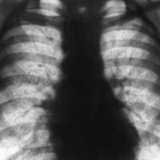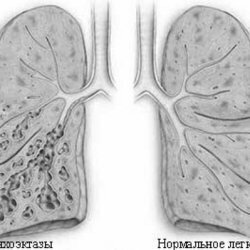Blood in the lungs: symptoms, treatment

When blood accumulates in the lungs, there is a sharp decrease in contractility in the left ventricle. In such cases, edema occurs with a reduced BP, unchanged venous inflow, reduced MOK.As a rule, activation of the sympathetic nervous system can lead not only to tachycardia and difficulty in emptying the left atrium, shortening the diastole, but also to spasms in the vessels of the large circle, this contributes to an even greater increase in the redistribution of blood and its accumulation in the lungs.
With uremia edema facilitates the delay of metabolites, which increase the permeability of capillaries and osmolarity in the interstitial fluid and the incidence of oncotic plasma pressure, i.e. hypoproteinemia. When the CNS is affected and the severe process of hypoxia swelling can provoke the release of histamine, serotonin in significant amounts. Generation of edema during the operation or the immediate postoperative period is more complicated.
Diseases associated with blood in the lungs, symptoms, signs
Abscess of the lung
This formation in the cavity with pus lung. Abscess of the lung develops after pneumonia in people with weakened immunity. Symptoms of the abscess are manifested in the form of a prolonged increase in body temperature, coughing, hot flushes of night sweats, decreased appetite, and chest pain. Cough with a lung abscess disease, as a rule, is observed with a copious separation of purulent sputum, in which veins of blood appear.
Chronic bronchitis.
In acute bronchitis, a cough with sputum is observed, in which there may sometimes be traces of blood, a rise in temperature. Chronic bronchitis is accompanied by a prolonged cough that lasts for more than three months, shortness of breath during physical exertion, slight elevations in body temperature with exacerbations of the disease. Blood in sputum is released in small amounts. Isolation occurs in the form of scarlet veins with purulent thick sputum.
Tuberculosis
The main symptoms of tuberculosis are a slight prolonged increase in body temperature, weight loss, appetite, and a prolonged cough with the release of purulent sputum and sometimes blood streaks.
Pneumonia
Pneumonia is manifested by the following symptoms: shortness of breath, fever, cough with rusty sputum and traces of fresh blood, pain in the chest.
Embolism of the pulmonary artery
Embolism refers to serious lung diseases, which are characterized by blockage of the lumen of the pulmonary artery. Embolism of the pulmonary artery can develop in people who have recently undergone some kind of surgery or in the presence of venous diseases. The main symptoms of pulmonary embolism are sudden and sharp pains behind the sternum, coughing up with blood, dyspnea. Cough with blood appears a few hours after the onset of chest pain.
Heart Disease
In cases of certain heart diseases due to blood circulation disorders in the lungs, blood stasis, pulmonary hypertension may develop. Symptoms of blood stagnation in the lungs can be pronounced dyspnea, which increases during physical exertion, cough with blood veins.
Cystic fibrosis
Cystic fibrosis refers to hereditary diseases that are characterized by impaired work in the glands. Cystic fibrosis of the respiratory system or respiratory cystic fibrosis can manifest itself with the following symptoms: cough with viscous sputum, prolonged frequent catarrhal diseases.
Coughing with blood is rarely taken with vomiting with blood, which occurs with certain diseases associated with diseases of the stomach, esophagus and duodenum. It can be a peptic ulcer or varicose veins of the esophagus. As a rule, in this case the blood is emitted dark red in the form of clots, bleeding profuse.
Diagnosis of the causes of coughing with blood in the lungs. Treatment of
When there is blood in the lungs, the symptoms, treatment are determined by the attending physician, which identifies the type of lung disease and prescribes the appropriate course of therapy.
There are several methods for diagnosing lung diseases. Radiography of the chest determines the condition of the lungs and heart. In the presence of blackouts in the lungs, there is a risk of detection of inflammation, pneumonia, lung abscess, lung cancer, or the presence of pulmonary embolism. Changes in the shape of the heart shadow in X-ray indications can lead to the suspected presence of heart defects.
Computed tomography allows you to determine the nature of the changes and assume the correct diagnosis of lung disease. Also, CT scan is used mainly in the diagnosis of lung abscess, lung cancer, tuberculosis, bronchiectasis.
Bronchoscopy is used to diagnose lung cancer or bronchiectasis. The bronchoscopy process is a study of bronchial lumens to determine changes in the walls of the bronchi - tumors, bronchial dilatation, and also to determine if the lungs or blood clots in the lungs.
A study of blood clotting capacity or a coagulogram is a study that reveals abnormalities associated with blood clotting.
Sweat analysis is used if there is a suspicion of cystic fibrosis. With this disease, chlorine metabolism in the body may be disrupted, the amount of chlorine detected by the analysis of sweat.
Fibroesophagogastroduodenoscopy( PHEGS) - examination of the upper sections in the digestive tract for the presence of diseases associated with the functioning of the esophagus, stomach and duodenum. As a rule, diseases of the esophagus like varicose veins of the esophagus in the presence of liver cirrhosis, peptic ulcer of the stomach and duodenum can become the cause of the appearance of blood in the lungs.
Treatment of a cough with blood largely depends on the cause of the development of the symptom. In lung cancer, the surgical method of treatment is most often prescribed. If the cause of a cough with blood is pulmonary tuberculosis, then treatment should be carried out with anti-tuberculosis medications.



